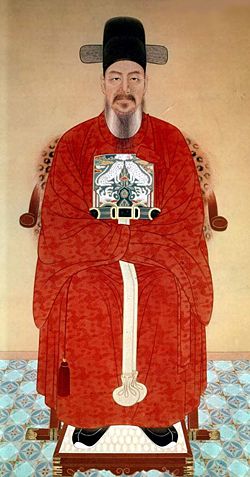Yi Sunshin
Yi Sunshin[1] (이순신:李舜臣, April 28, 1545 – December 16, 1598) was a Korean admiral renowned for his naval victories against the invading Japanese during the Korean War of 1592-1598.
Family & early life
Yi Sunshin was born on April 28, 1545 in the Geoncheon-dong area of Seoul. Yi was the third of the four sons begot by Yi Jeong (이정:李貞) and Chogyae Byeonssi (초계변씨:草溪卞氏)[2]. Despite their aristocratic yangban lineage, the family lived a modest life, since Yi's father opted to avoid pursuing the promising path of a Joseon Dynasty scholar official. The reason for this withdrawal of ambitions was Jeong's unpleasant memory of a violent political purge 20 years before, in which many government officials were killed, and many others, including Sunshin's grandfather Yi Baek-rok (이백록:李百祿), were demoted to the lower ranks.[3][4]
When Chogyae Byeonssi was pregnant with her third child, Yi Baek-rok, who was now deceased, appeared to her in a dream and said, "that child will turn out to be extraordinary, so name him 'Sunshin'."[5] Thus, like his brothers, Yi was named a "vassal" (shin) of one of the sage kings of ancient China (in this case, Shun).[6]
Not much is known about Yi's early life. The only significant detail regarding his childhood is that he became friends with Yu Seongnyong, who later would become a high ranking scholar official and contribute to Yi's appointment to admiralty.[6] After living about 9 years in Seoul, Yi Sunshin followed his family to the Bam-bat-ma-eul village in Asan,[7] where the Yi's could better get on, with support from their relatives on the mother's side.[8]
When Yi was 21, he married Sangju Bangssi (상주방씨:尙州方氏).[9][10]
A survey conducted by Sooncheonhyang University in 2005 indicated that Koreans generally regard Yi Sunshin to be the greatest figure in Korean history.[11]
notes
- ↑ Note: For Korean names, the western equivalent of the last name comes first, and the first name comes last. There is no middle name in Korean - "Sun" is not a middle name.
- ↑ Note: Korean women keep their last name upon marriage
- ↑ 선비가문, 지혜에 담력 갖춘 지장: 이순신과 임진왜란의 재조명 by Yi Naewon, Washington Hangook Ilbo, 2003-04-29, date accessed: 2008-07-27
- ↑ 기묘사화 (己卯士禍), Korea Britannica Encyclopedia, Daum.net, date accessed: 2008-07-27
- ↑ 이순신의 탄생과, 그 무렵의 국내 정세, 성웅 이순신 project, Asan municipal government. date accessed: 2008-07-27.
- ↑ 6.0 6.1 Hawley, 2005. pp. 118-122.
- ↑ 연대표, 성웅 이순신 project, Asan municipal government. date accessed: 2008-07-28.
- ↑ '제 2의 고향', 아산, 성웅 이순신 project, Asan municipal government. date accessed: 2008-07-28.
- ↑ 이순신, Korea Britannica Encyclopedia, Daum.net, date accessed: 2008-07-28
- ↑ 명장의 자질을 읽은 방진, 성웅 이순신 project, Asan municipal government. date accessed: 2008-07-28.
- ↑ Citizens Name Admiral Yi 'Greatest Korean', Chosun Ilbo, 2005-04-15, date-accessed: 2008-07-24
